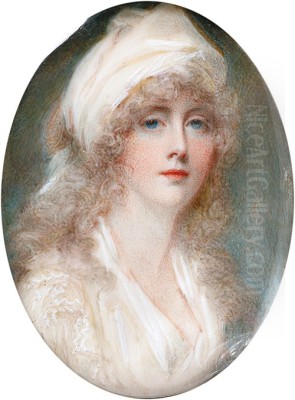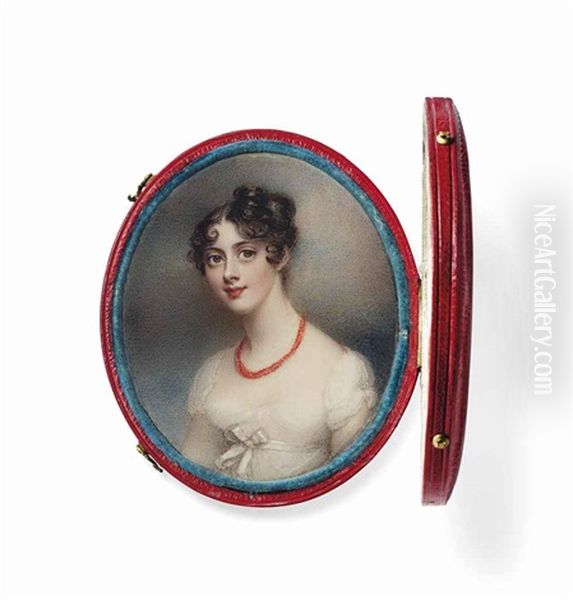
Anne Mee, a prominent figure in the world of British art during the late eighteenth and early nineteenth centuries, carved a distinguished career as a miniaturist, celebrated for her delicate and insightful portrayals of royalty, aristocracy, and the leading social figures of her time. Her life and work offer a fascinating glimpse into the artistic, social, and cultural currents of an era marked by significant change and burgeoning artistic talent. Despite the challenges faced by female artists, Mee achieved considerable success, leaving behind a legacy of exquisite miniature portraits that continue to be admired for their technical skill and intimate charm.
Early Life and Artistic Genesis
Born Anne Foldstone (or Foleson/Foldsone) in Bloomsbury, London, around 1765, she was the daughter of John Foldstone, himself a painter of miniatures, and Elizabeth Fair (or Fell). This familial connection to the art world likely provided an early exposure to the techniques and demands of portraiture. Her father's profession, though perhaps not widely acclaimed, would have immersed the young Anne in an environment where artistic creation was a part of daily life.
Tragedy struck early in Anne's life with the premature death of her father. This event placed considerable responsibility on her young shoulders, compelling her to utilize her burgeoning artistic talents to help support her family. This necessity likely accelerated her development as an artist, forcing her to hone her skills with a professional focus from a young age.
Her formal education included attendance at Madame Pomier's school in Bloomsbury, a French school for young ladies. While such establishments focused on accomplishments deemed suitable for women of the time, including perhaps drawing and painting, it was her innate talent and the pressing need to earn a livelihood that truly shaped her artistic trajectory. It is also documented that she received instruction from the renowned portrait painter George Romney (1734-1802), a significant influence whose own elegant and fluid style may have informed her developing aesthetic. Romney, a leading portraitist of the day, known for his sensitive portrayals, particularly of women and children, would have offered invaluable guidance in technique and composition.
Navigating a Professional Career and Marriage

Anne Mee's professional career began in earnest out of this necessity. She quickly gained a reputation for her skillful miniature portraits. Miniatures were highly fashionable items, serving as intimate keepsakes, tokens of affection, or symbols of loyalty. Their small scale demanded meticulous precision and a delicate touch, qualities that Mee evidently possessed in abundance.
Her personal life saw her marry Joseph Mee, an Irish barrister who, according to some accounts, presented himself as a man of greater means and connections than he actually possessed. It has been suggested that he leveraged his wife's artistic success and her access to high society for his own benefit. Despite any complexities in her personal life, Anne Mee's artistic output remained consistent and sought after.
An interesting anecdote, reflective of the societal constraints placed upon women, particularly in professional spheres, suggests that her husband forbade her from painting portraits of male sitters, deeming it improper. Whether entirely true or an exaggeration, this circumstance, if accurate, would have led her to concentrate her talents primarily on portraying women and children. This focus, however, did not limit her success; instead, she cultivated a strong and loyal clientele among the leading ladies of the aristocracy and gentry.
Royal Patronage and Esteemed Clientele
A significant turning point in Anne Mee's career was securing the patronage of the Prince of Wales, later King George IV. The Prince Regent was a renowned connoisseur and lavish patron of the arts, and his favour could make an artist's career. Mee painted numerous portraits for the royal family and their circle, solidifying her status as one of the foremost miniaturists of her day. This royal connection not only brought her prestigious commissions but also enhanced her reputation among the wider aristocracy.
Her sitters comprised a veritable who's who of the era. She captured the likenesses of duchesses, countesses, and ladies of high social standing. These portraits were not mere records of appearance; they often conveyed a sense of the sitter's personality and status, rendered with a characteristic grace and refinement. The intimacy of the miniature format allowed for a personal connection between the artwork and its owner, making Mee's works treasured possessions.
Artistic Style, Technique, and Notable Works
Anne Mee's style is characterized by its delicacy, refined draughtsmanship, and subtle use of colour. She typically worked in watercolour on ivory, the preferred medium for miniature painting due to its luminous quality, which lent a lifelike glow to the sitters' complexions. Her brushwork was exceptionally fine, allowing for intricate detail in costume, hair, and facial features, all within a very small compass.
Among her representative works, several stand out and illustrate her skill. The etching of Lady Dalrymple Hamilton, for which the engraving was completed by John Agar, showcases her ability to compose elegant portraits that could be translated into print. John Agar (c. 1773–1858) was a notable English engraver who reproduced the works of many contemporary artists, helping to disseminate their images to a wider public. His collaboration with Mee on works like this was crucial for broadening her reach.
Other significant pieces include her watercolour on ivory portraits of Louisa Hope, Duchess of St Albans, and Lady Charles Bentinck (Anne Wellesley, daughter of the 1st Marquess Wellesley). These works exemplify her mastery in capturing both the likeness and the fashionable elegance of her aristocratic subjects. The portrait of The Hon. Louisa Hope (later Lady Beresford) is another fine example, often praised for its charm and sensitivity.
A work described as Georgian Era lady wearing a colorful turban further points to her engagement with the fashionable styles of the period, where exotic accessories like turbans were popular. She also painted group subjects or narrative pieces, such as A young woman, dressed in a white gown and Eliza, a bride wearing a white dress, indicating a versatility beyond single-figure portraits.
Her involvement with projects like the Gallery of Beauties of the Court of George III (also known as The Belle Assemblée or similar titles for collected engravings of court beauties) further underscores her prominence. This publication, featuring engravings after her portraits, made her images accessible to a broader public and cemented her reputation for capturing the leading beauties of the age.
Exhibitions and Public Recognition
Anne Mee's work was recognized through exhibitions at prestigious institutions. She exhibited at the Royal Academy of Arts in London, a key venue for artists to showcase their talents and secure commissions. Between 1815 and 1837, she regularly exhibited there under the name "Mrs. Mee." The Royal Academy, founded in 1768 with Sir Joshua Reynolds as its first president, was the epicentre of the British art world. While female artists faced more barriers than their male counterparts, the Academy did admit some women as exhibitors. Two women, Angelica Kauffman (1741-1807) and Mary Moser (1744-1819), were even among its founding members, though full equality for female academicians would take much longer.
Mee's participation in these exhibitions placed her work in dialogue with that of other leading artists of the day. The landscape of British art during her active period was rich and varied. In portraiture, Sir Thomas Lawrence (1769-1830) was the dominant figure, succeeding Reynolds as the premier painter to the elite. His flamboyant style and psychological insight set a high bar. In Scotland, Sir Henry Raeburn (1756-1823) was a leading portraitist, known for his strong characterizations.
Within the specialized field of miniature painting, Mee was a contemporary of other notable practitioners. Richard Cosway (1742-1821) was perhaps the most famous and fashionable miniaturist of the Regency era, known for his dashing style and "pearly" flesh tones. His wife, Maria Cosway (1760-1838), was also an accomplished artist and musician. Other significant miniaturists included John Smart (c. 1740-1811), known for his precise and vibrant works, often from his time in India, and Ozias Humphry (1742-1810), who also worked in India and was appointed Portrait Painter in Crayons to the King. Andrew Robertson (1777-1845) was another prominent miniaturist, influential in elevating the status of the art form.
A particularly relevant contemporary was Emma Eleonora Kendrick (c. 1788-1871), another successful female miniaturist. Kendrick exhibited extensively at the Royal Academy and other venues, was appointed Miniature Painter to King William IV in 1831, and even published a treatise on miniature painting. The presence of artists like Kendrick and Mee demonstrates that women could and did achieve significant professional success in this demanding field.
The Wider Artistic Context and Collaborations
The era in which Anne Mee worked was one of great artistic ferment. The late Georgian and Regency periods saw a flourishing of portraiture, landscape painting (with artists like J.M.W. Turner and John Constable beginning their rise), and genre scenes. The demand for portraits, from grand full-lengths to intimate miniatures, was immense, fueled by a wealthy aristocracy and a growing middle class eager to emulate their social superiors.
The role of engravers like John Agar was crucial in this ecosystem. Engravings allowed paintings, particularly portraits, to be reproduced and circulated widely, appearing in books, magazines, and as individual prints. This not only spread an artist's fame but also made art accessible to a wider audience than could view the original paintings. Agar's work in translating Mee's delicate watercolours into the linear medium of engraving required considerable skill to retain the character and charm of her originals.
Mee's father, John Foldstone, though less famous, was part of an earlier generation of miniaturists. The tradition of miniature painting in Britain was rich, with artists like Nicholas Hilliard and Isaac Oliver in the Elizabethan and Jacobean eras establishing it as a significant art form. By Mee's time, the techniques had evolved, with ivory becoming the standard support, but the fundamental appeal of these small, personal objects remained.
Other artists whose careers overlapped or immediately preceded Mee's, and who contributed to the vibrant London art scene, include Richard Wilson (1714-1782), a pioneer of British landscape painting, and Thomas Gainsborough (1727-1788), a master of both portraiture and landscape. While their primary genres differed from Mee's specialization, their presence contributed to the overall artistic environment in which she worked. The influence of Sir Joshua Reynolds (1723-1792), the first president of the Royal Academy, was also pervasive, shaping ideals of portraiture and artistic practice for generations.
Later Years and Enduring Legacy
Anne Mee continued to paint throughout her long life. She witnessed significant changes in artistic taste and the advent of photography in her later years, which would eventually challenge the role of miniature portraiture as the primary means of creating small, portable likenesses. However, during her prime, her contributions were substantial.
She passed away in Hammersmith, London, on May 25, 1851 (some sources suggest April 28, 1851), at the advanced age of around 86. Her career spanned several decades, from the late reign of George III, through the Regency of George IV, and into the early Victorian era.
Anne Mee's legacy lies in her beautiful and numerous miniature portraits, which provide an invaluable visual record of the society in which she moved. Her success as a female artist in a male-dominated profession, particularly one who relied on her art for her livelihood from a young age, is noteworthy. She navigated the social and professional landscape with skill, securing elite patronage and maintaining a long and productive career.
Her works are held in various public and private collections, including the Royal Collection Trust, and continue to be admired for their technical finesse, their delicate charm, and the intimate glimpse they offer into the faces and personalities of a bygone era. She remains an important figure in the history of British miniature painting, a testament to her talent, perseverance, and the enduring appeal of her art. Her ability to capture not just a likeness but a sense of the individual's character within such a small scale ensures her place among the distinguished portraitists of her time.